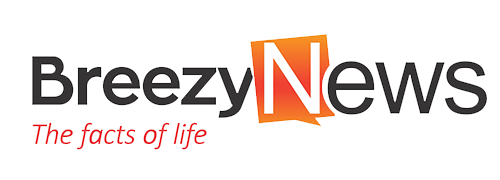A three-year-old girl from South Africa, Lethukhanya Mjaja was sent to buy a loaf of bread. She got fascinated with muddy water that she started playing in it while still holding the loaf of bread she was sent to buy. She was completely lost in her imaginative world in the muddy water that she became unaware of her uncle who is a commercial photographer.
Unlike most people the talented Uncle took some photos of her and posted them online. The pictures went viral and became the talk of South Africa’s social media space.
Lethukhanya caught the attention of the company that produces the bread. It decided to use the picture on its billboards and delivery trucks. This increased the sales of the company’s product massively, so it reciprocated by rewarding the little girl in cash and kind. And also signed her as its brand ambassador.
From a childish carefree play in a muddy water, little Lethukhanya became the face of one of South Africa’s leading bread brands. She went from a bread buyer to a breadwinner for her family.
This public relations success story draws parallels with the transformation of Jumoke, a breadseller turned celebrity, showcasing the power of unexpected moments and the role of effective PR in shaping narratives.
Here are the lessons:
1. Seizing unexpected opportunities
Professional PR practitioners should always be alert to unexpected moments or content that has the potential to go viral. Capitalising on these opportunities can create significant brand exposure and generate positive buzz.
2. Social media amplification
Social media can serve as a powerful tool for amplifying stories and reaching a wide audience quickly. Creating visually engaging content that resonates with the target audience can significantly enhance message dissemination.
3. Emotional connection and brand association
The bread company recognised the unique opportunity presented by Lethukhanya’s viral photos and decided to capitalise on her innocent charm. By incorporating the images into their billboards and delivery trucks, it established a strong emotional connection between the brand and the audience.
Crafting PR campaigns that evoke genuine emotions and foster connections with the target audience can be a powerful tool for brand promotion. A study by Neuroscience Marketing shows that, “the success rate of emotional marketing campaigns is 31 per cent”.
4. Strategic partnerships
The bread company rewarded Lethukhanya in cash and kind, acknowledging her unintentional contribution to their success. This act of appreciation created a positive narrative surrounding the brand, generating goodwill and strengthening their reputation.
Building strategic partnerships and fostering positive relationships with stakeholders, including accidental influencers, can lead to mutually beneficial outcomes. Recognising and rewarding individuals who contribute to the brand’s success can foster goodwill and generate positive word-of-mouth.
5. Leveraging user-generated content
User-generated content can add credibility and authenticity to PR efforts. Encouraging customers to share their experiences and stories can provide valuable content for campaigns and foster a sense of community around the brand.
6. Recognising and rewarding contributions
Acknowledging the contributions of accidental influencers or individuals who contribute to a brand’s success can generate goodwill and positive sentiment. Rewarding them demonstrates appreciation and can enhance the brand’s reputation.
The brand’s genuine engagement and appreciation towards Lethukhanya garnered positive media coverage and public sentiment. This strengthened their reputation, as they were seen as a socially responsible and customer-centric company.
7. Visual storytelling
In the book, Critical Narrative as Pedagogy by two researchers, Ivor Goodson and Scherto Gill define visual storytelling “as a story told primarily through the use of visual media”. This can be images in the mind, digital, and traditional media.
Leveraging visually captivating content can capture audience attention and spark conversations. Visual assets can evoke emotions, enhancing brand recall and recognition.
Ever hear the saying, “a picture is worth a thousand words”? Several studies have shown that the brain processes visuals 60,000 times faster than text. And a marketing research revealed that, “people are 85 percent more likely to buy a product after viewing a product video”.
In conclusion, Lethukhanya’s PR journey exemplifies the power of viral moments and effective public relations in shaping brand narratives. By leveraging social media, fostering emotional connections, and recognising the unintentional contribution of individuals, brands can transform unexpected encounters into impactful success stories.
PR professionals can learn from this case study by embracing authenticity, seizing opportunities, and building meaningful connections with stakeholders.
Ayodele is a communications strategist who specialises in “Message Engineering”. He helps brands, organisations and leaders communicate in a way that yields the desired result. He can be reached on +2348077932282, ishopr2015@gmail.com







